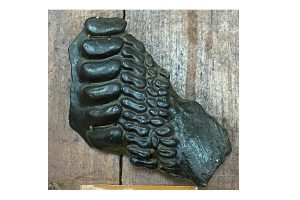Cast of mandible – Coelodus ellipticus, Egerton
Phylum: Chordata
Order: Pycnodontiformes
Order: Pycnodontidae
Kingdom : Animalia
Formation : Gault Formation
Country- United Kingdom
Continent – Europe
Class- Osteichthyes
Right mandible (lower Jaw) with most of the crown (tritoral) teeth. The dental armature is composed

of four ranks on the anterior and three on the posterior area of the mandible. The inner row consists of teeth very considerably larger than those of the succeeding rows. Six of these are retained. The individual teeth are elliptic in outline, but slightly crescentic on the anterior margin. The four anterior plates show progressive marks of attrition; but the fifth and sixth, do not have these marks. It is supposed that fifth and sixth not have contact with the vomerine teeth. The whole triturating (crown) surface is coated with thick and lustrous enamel.
(b) The second rank contains eleven teeth of an elongated elliptic form, constricted at the waist, like an hour-gla
ss. They all have the longitudinal furrow characteristic of the larger teeth.
(c) The four posterior teeth of the third row are smaller than those of the second, and the outline is less elliptic and more irregular. They also have central furrow.
(d) The teeth in front of these are in a double row, and seem to have arisen from divided germ, each pair making up the form and size of one of the posterior teeth.
Gault Formation is a geological Formation of stiff blue clay deposited in a calm, fairly deep-marine environment dining lower Cretaceous period ( upper and Middle Albian age ). It is well exposed in the coastal cliffs. It over lays the Lower Green sand formation and underlies the upper Greensand formations.
The late Cretaceous ( Cenomanian- Maastrichtian) English chalk and Eocene (Ypresian) London clay are two fossiliferous British Marine deposits that are significant in the history of palaeontology generally and palaeoichthyology specifically. The actinopterygians ( ray-finned fishes) of the chalk and London clay are notable not diversity, but also for their remarkable preservation. Unlike most fish faunas of comparable age, in which specimens are preserved as greatly flattened compression fossils, these British deposits yield three-dimensionally preserved specimens of either whole individuals (chalk ) or heads(London Clay). The popularity of fossil hunting in the London clay during the mid 1800 s led to James Bowerbank’s foundation of the London clay club(1836-47), which eventually give rise to the modern palaeontographical society. The English chalk and London clay provided ample material for study and description by Arthur Smith Woodward. Natural History Museum,London houses the finest collection of fossil fishes from there localities.
Source
Geological Magazine Decade II , Vol No.2 . February, 1877.
